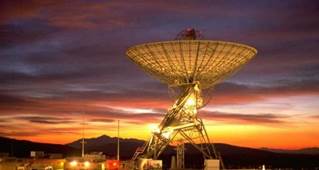SARAS TELESCOPE

Disclaimer: Copyright infringement not intended.
Context
- Using SARAS Telescope scientists have determined properties of radio luminous galaxies formed just 200 million years post the Big Bang, a period known as the Cosmic Dawn thus providing an insight to the properties of the earliest radio loud galaxies that are usually powered by supermassive black holes.
SARAS Telescope
- Shaped Antenna measurement of the background Radio Spectrum 3 (SARAS) telescope -- indigenously designed and built at Raman Research Institute -- was deployed over Dandiganahalli Lake and Sharavati backwaters, located in Northern Karnataka, in early 2020.
Recent Findings
- Scientists were able to look back in time just 200 million years after the Big Bang and provide new insight into the properties of galaxies at the time.
- SARAS 3 has improved our understanding of astrophysics of Cosmic Dawn, telling us that less than 3 percent of the gaseous matter within early galaxies was converted into stars, and that the earliest galaxies that were bright in radio emission were also strong in X-rays, which heated the cosmic gas in and around the early galaxies.
- Scientists observed radiation from hydrogen atoms in and around the galaxies, emitted at a frequency of approximately 1420 MHz.
- The radiation is stretched by the expansion of the universe, as it travels to us across space and time, and arrives at Earth in lower frequency radio bands 50-200 MHz, also used by FM and TV transmissions.
- The cosmic signal is extremely faint, buried in orders of magnitude brighter radiation from our own Galaxy and man-made terrestrial interference, making its detection a challenge for astronomers.
- The results from the SARAS 3 telescope are the first time that radio observations have been able to provide an insight to the properties of the earliest radio loud galaxies that are usually powered by supermassive black holes.
|
Radio galaxy A radio galaxy is a galaxy with giant regions of radio emission extending well beyond its visible structure. These energetic radio lobes are powered by jets from its active galactic nucleus. They have luminosities up to 1039 W at radio wavelengths between 10 MHz and 100 GHz. Radio-loud active galactic nuclei (radio galaxies and radio-loud quasars; hereafter RLAGN) are a subset of the active galaxy population in which accretion onto the central supermassive black hole of a galaxy generates a relativistic jet of charged particles (electrons, positrons, and/or protons) and magnetic field. |
https://pib.gov.in/PressReleasePage.aspx?PRID=1879653





1.png)
